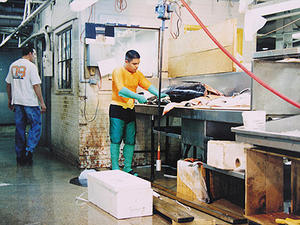ImmigrationU.S. economy influences immigration more than security measures
A Forbes’ columnist says that immigrants — legal and illegal — are an economic bellwether, and that recent rends in immigration show that both the low-skilled and high-skilled immigrants have doubts about the U.S. economy right now; a DHS study shows that overall population of unauthorized aliens in the United States dropped from 11.8 million in 2007 to 10.8 million in 2009, in parallel with the economic slow-down; the risk to U.S. national security and economic welfare are these: low-skilled immigrants will likely return when the U.S. economy picks up again, but to bring back high-skilled immigrants, America’s economy will have to do more than make a comeback — it will have to make a strong comeback

According to Forbes, less work in the U.S. means less immigrants entering // Source: latinalista.net
Immigrants, legal and illegal, are an economic bellwether. Recent rends in immigration show that both the low-skilled and high-skilled immigrants have doubts about the U.S. economy right now.
According to a January study by DHS, overall population of unauthorized aliens in the United States dropped from 11.8 million in 2007 to 10.8 million in 2009. Opponents of immigration attribute this to tougher border controls, but Shikha Dalmia writes in Forbes that state-level data from the study show two things: One, this drop has little to do with stepped-up border enforcement, and two, it has a lot to do with the economic health of a state.
Dalmia notes that, in fact, if one sets aside New York, which experienced a drop in the illegal population despite being in the second-highest quintile in terms of economic growth, this pattern is pretty clear. For example, California, whose economy has seen better days, saw an 8.4 percent drop in its illegal population between 2007 and 2009. Florida, which is in the bottom quintile of economic performers, saw a 25 percent drop in the same time period, and New Jersey, which is in the second bottom quintile, 23 percent.
Interestingly, Arizona, which is in the lowest quintile, has seen only a 13 percent drop, less than Florida or New Jersey, “even though those two do not have Sheriff Joe Arpaio running around harassing their Hispanic population,” Dalmia writes. By contrast, Texas, which is in the second highest quintile, has seen less than a 1.7 percent drop in its illegal population since 2007, even though it has been erecting many miles of high-tech fences, thanks to increased border enforcement dollars from Uncle Sam.
The U.S. sputtering economy is not just turning off low-skilled immigrants. High-skilled immigrants — who face relatively less hostility — are spurning it, too. The clearest evidence of this is the number of applications for H1-B visas or work permits that allow them legally to work in this country. Dalmia writes that prior to the recession, the entire 85,000 H1-B quota for the year would be filled within days of its becoming available on 1 April. Microsoft CEO Bill Gates and other hi-tech industry leaders were pleading with Congress to raise this quota because they could not hire enough foreign workers.
This is not the situation anymore. In the 2010 fiscal year, the H-1B quota was reached in December 2009. In the 2011 fiscal year (which starts 1 October) it is likely to take even longer, according to Stuart Anderson of the National Foundation for American Policy, a research organization.
Even this does not fully capture the waning interest of foreign tech professionals in America. It is not just that they are not coming to the U.S. as much anymore. The ones who are here are increasingly returning home, producing a reverse brain drain, notes Vivek Wadhwa, a senior research associate at the Harvard Law School who has been studying the phenomenon for years now. The U.S. government does not track returning émigrés, but Wadhwa estimates that about a third of the start-ups in India have been founded by returnees. What is more, at one recent meeting with Indian tech professionals in Silicon Valley, Wadhwa found that about three-quarters of them planned to return home.
Those going back are not just new immigrants who are deterred by the prospect of navigating the U.S. green-card system. Wadhwa polled 1,023 returnees and found that 27 percent of Indians and 34 percent Chinese actually had green cards. Why are they retuning? Many of them cited personal reasons such as the difficulty of being separated from family and friends — but some 84 percent of the Chinese and 69 percent of the Indians — a vast majority with advanced degrees in engineering and management — cited better professional opportunities in their own countries, which have been liberalizing their economies. Many of them felt that America’s best days were over whereas in India and China the best was yet to come.
Dalmia concludes by saying that low-skilled immigrants will likely return when the U.S. economy picks up again. To bring back high-skilled immigrants, however, America’s economy will have to do more than make a comeback. It will have to make a strong comeback.
She offers an advice to president Obama: “forget about ‘comprehensive immigration reform.’ It serves neither the interests of immigrants nor Americans.” Instead, he should remember Bill Clinton’s slogan: “It’s the economy, stupid.”
